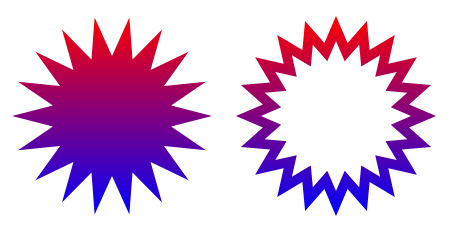.box {
width: 200px;
aspect-ratio: 1;
background: linear-gradient(red, blue);
display: inline-block;
margin: 10px;
clip-path: polygon(100.00% 50.00%, 79.54% 55.21%, 96.98% 67.10%, 75.98% 65.00%, 88.30% 82.14%, 69.28% 72.98%, 75.00% 93.30%, 60.26% 78.19%, 58.68% 99.24%, 50.00% 80.00%, 41.32% 99.24%, 39.74% 78.19%, 25.00% 93.30%, 30.72% 72.98%, 11.70% 82.14%, 24.02% 65.00%, 3.02% 67.10%, 20.46% 55.21%, 0.00% 50.00%, 20.46% 44.79%, 3.02% 32.90%, 24.02% 35.00%, 11.70% 17.86%, 30.72% 27.02%, 25.00% 6.70%, 39.74% 21.81%, 41.32% 0.76%, 50.00% 20.00%, 58.68% 0.76%, 60.26% 21.81%, 75.00% 6.70%, 69.28% 27.02%, 88.30% 17.86%, 75.98% 35.00%, 96.98% 32.90%, 79.54% 44.79%);
}
.alt {
clip-path: polygon(100.00% 50.00%, 86.54% 55.79%, 97.55% 65.45%, 82.97% 66.80%, 90.45% 79.39%, 76.16% 76.16%, 79.39% 90.45%, 66.80% 82.97%, 65.45% 97.55%, 55.79% 86.54%, 50.00% 100.00%, 44.21% 86.54%, 34.55% 97.55%, 33.20% 82.97%, 20.61% 90.45%, 23.84% 76.16%, 9.55% 79.39%, 17.03% 66.80%, 2.45% 65.45%, 13.46% 55.79%, 0.00% 50.00%, 13.46% 44.21%, 2.45% 34.55%, 17.03% 33.20%, 9.55% 20.61%, 23.84% 23.84%, 20.61% 9.55%, 33.20% 17.03%, 34.55% 2.45%, 44.21% 13.46%, 50.00% 0.00%, 55.79% 13.46%, 65.45% 2.45%, 66.80% 17.03%, 79.39% 9.55%, 76.16% 23.84%, 90.45% 20.61%, 82.97% 33.20%, 97.55% 34.55%, 86.54% 44.21%, 100% 50%, calc(100% - 25px) 50%, calc(86.54% - 18.27px) calc(44.21% - -2.89px), calc(97.55% - 23.78px) calc(34.55% - -7.73px), calc(82.97% - 16.48px) calc(33.20% - -8.40px), calc(90.45% - 20.23px) calc(20.61% - -14.69px), calc(76.16% - 13.08px) calc(23.84% - -13.08px), calc(79.39% - 14.69px) calc(9.55% - -20.23px), calc(66.80% - 8.40px) calc(17.03% - -16.48px), calc(65.45% - 7.73px) calc(2.45% - -23.78px), calc(55.79% - 2.89px) calc(13.46% - -18.27px), calc(50.00% - -0.00px) calc(0.00% - -25.00px), calc(44.21% - -2.89px) calc(13.46% - -18.27px), calc(34.55% - -7.73px) calc(2.45% - -23.78px), calc(33.20% - -8.40px) calc(17.03% - -16.48px), calc(20.61% - -14.69px) calc(9.55% - -20.23px), calc(23.84% - -13.08px) calc(23.84% - -13.08px), calc(9.55% - -20.23px) calc(20.61% - -14.69px), calc(17.03% - -16.48px) calc(33.20% - -8.40px), calc(2.45% - -23.78px) calc(34.55% - -7.73px), calc(13.46% - -18.27px) calc(44.21% - -2.89px), calc(0.00% - -25.00px) calc(50.00% - 0.00px), calc(13.46% - -18.27px) calc(55.79% - 2.89px), calc(2.45% - -23.78px) calc(65.45% - 7.73px), calc(17.03% - -16.48px) calc(66.80% - 8.40px), calc(9.55% - -20.23px) calc(79.39% - 14.69px), calc(23.84% - -13.08px) calc(76.16% - 13.08px), calc(20.61% - -14.69px) calc(90.45% - 20.23px), calc(33.20% - -8.40px) calc(82.97% - 16.48px), calc(34.55% - -7.73px) calc(97.55% - 23.78px), calc(44.21% - -2.89px) calc(86.54% - 18.27px), calc(50.00% - 0.00px) calc(100.00% - 25.00px), calc(55.79% - 2.89px) calc(86.54% - 18.27px), calc(65.45% - 7.73px) calc(97.55% - 23.78px), calc(66.80% - 8.40px) calc(82.97% - 16.48px), calc(79.39% - 14.69px) calc(90.45% - 20.23px), calc(76.16% - 13.08px) calc(76.16% - 13.08px), calc(90.45% - 20.23px) calc(79.39% - 14.69px), calc(82.97% - 16.48px) calc(66.80% - 8.40px), calc(97.55% - 23.78px) calc(65.45% - 7.73px), calc(86.54% - 18.27px) calc(55.79% - 2.89px), calc(100.00% - 25.00px) calc(50.00% - 0.00px));
}
<div class="box"></div>
<div class="box alt"></div>




